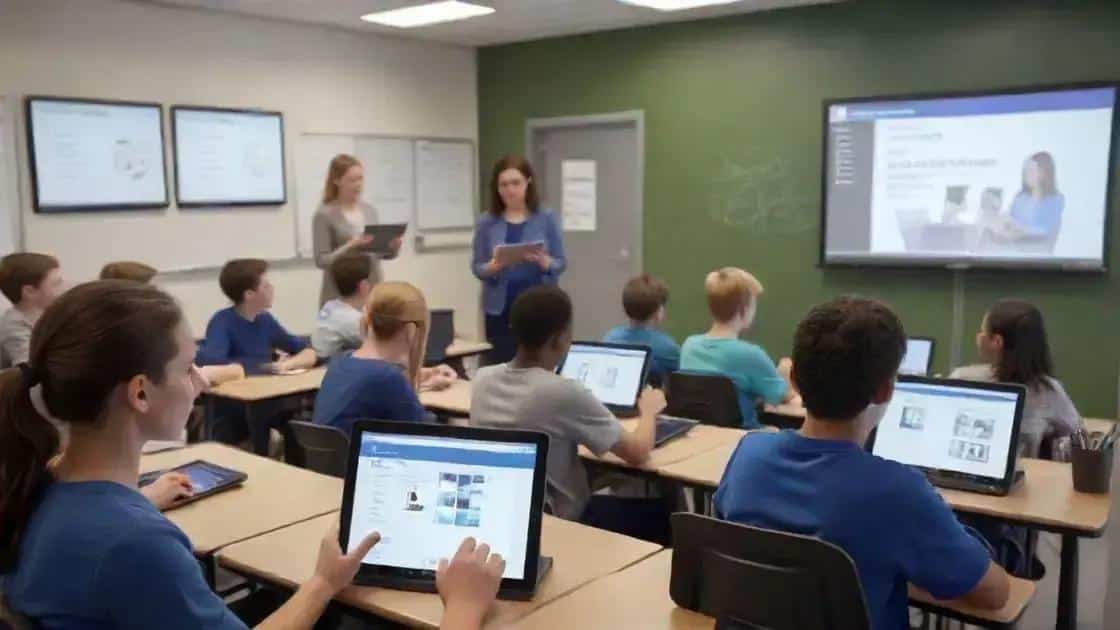Century digital classroom best practices you need to know

Best practices for digital classroom management involve utilizing technology, fostering collaboration, and implementing continuous assessments to enhance student engagement and learning outcomes.
In the evolving landscape of education, century digital classroom best practices are crucial for fostering an engaging learning environment. Have you considered how these practices can impact your teaching? Let’s dive in!
Understanding the century digital classroom concept
Understanding the century digital classroom concept is essential for teachers looking to engage students effectively. This approach incorporates technology to enhance the learning experience, making education more interactive and accessible.
What is a Century Digital Classroom?
A century digital classroom blends traditional teaching methods with modern technology. It emphasizes collaboration, creativity, and critical thinking. This type of environment uses tools like tablets, interactive whiteboards, and educational software to enrich lessons.
Key Features of the Century Digital Classroom
- Integration of technology, such as tablets and laptops.
- Access to online resources and educational platforms.
- Real-time feedback and assessment tools.
- Opportunities for collaboration through online discussions.
In a century digital classroom, students are encouraged to participate actively. They can work in groups, share ideas, and learn from each other. This kind of engagement makes learning more meaningful and memorable.
Additionally, technology allows teachers to customize lessons. They can track student progress and adjust their teaching methods to meet individual needs. This tailored approach fosters a supportive learning atmosphere where every student can succeed.
Benefits for Students
Adopting century digital classroom practices provides numerous benefits. Students become more motivated as they engage with interactive content. They develop digital literacy skills that are crucial in today’s world.
- Enhances problem-solving abilities.
- Encourages self-paced learning.
- Improves communication and teamwork.
In conclusion, understanding the century digital classroom concept allows educators to create inclusive and dynamic learning environments. By embracing technology, they can significantly improve student outcomes and prepare learners for the future.
Engaging students in a digital environment
Engaging students in a digital environment is vital for modern education. It transforms how learners interact with content and each other. Active participation keeps students motivated and enhances their understanding.
Creating Interactive Lessons
To enhance engagement, teachers can create interactive lessons. Using tools like quizzes and polls during class can stimulate dialogue and excitement. Interactive resources allow students to play an active role in their learning.
Fostering Collaboration
Technology enables collaboration among students. Utilizing platforms for group projects encourages teamwork and communication. When students work together, they learn from each other, which deepens their understanding.
- Online discussion boards enhance communication.
- Collaborative documents allow real-time input.
- Group video calls foster a sense of community.
In an effective digital environment, feedback is immediate. Students receive insights on their performance quickly, helping them adjust their learning strategies. This approach promotes a growth mindset, as they understand their strengths and areas for improvement.
Employing gamification can also significantly increase student engagement. By integrating game-like elements into lessons, such as points, badges, or leaderboards, learning becomes fun. This strategy taps into students’ competitive spirit and motivates them to strive for success.
Incorporating Multimedia
Multimedia resources make lessons more appealing. Videos, podcasts, and interactive simulations can illustrate complex concepts effectively. By using various media, teachers can cater to different learning styles, ensuring all students can engage meaningfully.
- Visual aids enhance comprehension.
- Podcasts allow for flexible learning opportunities.
- Simulations encourage active participation and application of knowledge.
Ultimately, engaging students in a digital environment requires creativity and flexibility. Teachers must adapt their methods to fit the needs and interests of their students. By fostering a dynamic classroom atmosphere, educators can inspire a love for learning.
Utilizing technology to enhance learning outcomes

Utilizing technology to enhance learning outcomes is essential in today’s educational landscape. With the right tools, educators can create more engaging and effective lessons to improve student understanding.
Types of Technology to Use
Various technologies can be integrated into the classroom. Learning management systems (LMS) are popular choices as they help organize coursework and track student progress. These platforms can streamline communication between teachers and students.
Interactive Learning Tools
Interactive tools, such as virtual reality (VR) and augmented reality (AR), offer immersive experiences. These technologies allow students to explore new concepts in engaging ways. For instance, a VR field trip can bring history to life, making learning more memorable.
- Gamification increases motivation through competition.
- Simulation software aids in understanding complex subjects.
- Online quizzes provide immediate feedback and assessment.
Furthermore, employing educational apps enables personalized learning. These applications can address each student’s unique needs and learning pace. This personalized approach encourages students to take ownership of their education.
Teachers can also use data analytics to monitor student progress. By analyzing performance metrics, educators can identify areas where students struggle. This information helps them adjust lesson plans to meet students’ needs effectively.
Improving Communication
Technology enhances communication between students, teachers, and parents. Online platforms facilitate discussions and collaboration. Regular updates keep everyone informed about student progress.
- Discussion forums encourage student interaction.
- Video conferencing expands learning opportunities beyond the classroom.
- Digital portfolios highlight student achievements over time.
Integrating technology to enhance learning outcomes fosters a more dynamic classroom environment. When used effectively, it can significantly increase student engagement and understanding. Educators who embrace technology will be better equipped to prepare students for the challenges ahead.
Best practices for digital classroom management
Best practices for digital classroom management play a crucial role in creating an effective learning environment. Teachers can use various strategies to ensure students are engaged and learning effectively in digital classrooms.
Establishing Clear Expectations
Setting clear expectations is fundamental in a digital classroom. Students should understand the rules regarding participation and behavior. This clarity helps create a respectful and productive learning atmosphere.
Utilizing Classroom Management Tools
Technology offers classroom management tools that help track student progress. Learning management systems (LMS) can automate tasks, such as grading and attendance. By using these tools, educators can focus more on teaching and less on administrative duties.
- Use online platforms for assignments and feedback.
- Implement communication tools for quick updates.
- Track student performance through analytics.
Additionally, keeping resources organized is vital. A well-structured digital space allows students to access materials easily. When they know where to find assignments and resources, they can concentrate on learning.
Another critical aspect is to create a supportive community. Encouraging collaboration among students fosters teamwork and strengthens relationships. This can be done through group projects or discussion forums, where students can share ideas and help each other.
Encouraging Student Engagement
Incorporating interactive elements is beneficial for digital classroom management. Using polls, quizzes, and gamification keeps students interested. These elements motivate students to participate actively rather than passively consuming information.
- Incorporate multimedia presentations to cater to different learning styles.
- Offer choices in assignments to boost student interest.
- Regularly seek student feedback to improve the learning experience.
Lastly, maintain open lines of communication with students. Regular check-ins can help address any issues they may encounter. When students feel supported, they are more likely to succeed academically in a digital environment.
Assessment strategies for the digital age
Assessment strategies for the digital age are evolving rapidly, adapting to new technologies and teaching methods. Traditional tests are not always effective in measuring student understanding in a digital classroom. Therefore, it’s crucial to explore innovative assessment strategies.
Formative Assessments
Formative assessments are ongoing checks of student understanding during the learning process. These assessments help educators tailor their teaching methods. Examples of formative assessments include quizzes, polls, and interactive discussions. By using online tools, teachers can quickly gauge what students grasp and areas needing improvement.
Using Technology for Assessments
Technology enhances the effectiveness of assessments. Tools like online quizzes can provide instant feedback, allowing students to understand their mistakes right away. Additionally, learning management systems (LMS) can track progress and offer personalized learning paths based on assessment results.
- Digital portfolios allow students to showcase their work and reflect on their learning.
- Peer assessments encourage collaboration and critical thinking.
- Gamification elements can motivate students and make assessments more engaging.
Another important strategy is to implement authentic assessments. These assess students’ abilities to apply skills in real-world situations. Projects, presentations, and simulations can effectively evaluate a student’s understanding of concepts while fostering creativity and problem-solving skills.
Regularly adapting assessment methods is essential. Educators should seek student feedback on the assessment processes. Understanding student perspectives can lead to improvements that make assessments more effective and relevant.
Data Analytics for Improvement
Data analytics play a crucial role in refining assessment strategies. Teachers can analyze detailed reports on student performance to identify trends and areas requiring attention. This analysis can directly inform teaching practices, helping educators better meet their students’ needs.
- Using analytics to track progress over time shows growth and learning trends.
- Identifying gaps in knowledge helps in modifying lesson plans.
- Data-driven decisions improve overall classroom strategies.
Ultimately, effective assessment strategies for the digital age blend technology with innovative teaching practices. By embracing these strategies, educators can enhance learning outcomes and prepare students for future challenges.
FAQ – Frequently Asked Questions about Digital Classroom Management
How can technology improve student engagement?
Technology makes learning more interactive and fun, using tools like gamification and multimedia to keep students motivated.
What are formative assessments?
Formative assessments are ongoing evaluations that provide feedback during the learning process, helping teachers make necessary adjustments.
Why is collaboration important in a digital classroom?
Collaboration fosters teamwork and communication skills, allowing students to learn from each other and engage more deeply with the material.
How can data analytics help in education?
Data analytics provide insights into student progress, allowing educators to identify trends and tailor their teaching strategies effectively.






